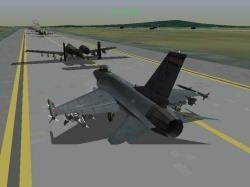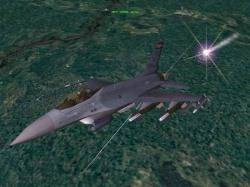|
Chosin: China's Revenge for Falcon 1.08i patch By David "Hunter" Proeber |
||||
|
The first thing you will notice about Chosin: China's Revenge is that there are no scheduled allied flights. It's not a bug, but an opportunity to create your own Air Tasking Order (ATO) to resolve a very difficult political problem. Chosin: China's revenge is a 24 hour T.E. campaign written for the Falcon 1.08i patch. It is based on actual events during the Korean War when General Douglas McArthur commanded his army to advance to the Yalu River, the border between North Korea and China in the fall of 1950. This campaign will not only offer some insights into that historical conflict, it seeks to help Falcon pilots understand some real concepts employed by modern air force planners who have formulated strategy for problem solving beyond the tactical level. HISTORY The Korean War began on June 25, 1950, when North Korea invaded the South. The invasion came after a number of administration officials made it clear to the world that Korea was "outside the sphere of U.S. influence." An ill-prepared South Korean army and token U.S. Army units were pushed to the tip of the peninsula at Pusan. McArthur's invasion at Inchon on September 15, 1950, coupled with a South Korean breakout from Pusan, plunged the North Korean army into chaos. By September 29, U.S. troops had captured Seoul and were preparing for an assault of Pyonyang. The swift allied advance did not go unnoticed in Peking. Warnings had been delivered to the U.S. ambassador in Moscow: if the U.S. crosses the 38th parallel, China will intervene. Chou En-lai, in fact, stated the same message publicly, the day Seoul fell. Outwardly, China said it couldn't tolerate watching imperialists invade a neighbor. Privately, it feared McArthur was planning to invade Manchuria. The reservoirs along the Yalu were critical to the economy of the region. A number of hydro electric dams, shared with North Korea, had turned the Yalu into an important economic resource for the Chinese. Their loss would be viewed as potentially catastrophic. Truman had ordered McArthur to take make no further aggressive moves without administration approval. Announcing the war was all but over, McArthur plunged forward, attacking Communist troops deep into the heart of North Korea. The forward line of troops in Chosin: China's revenge approximate the position of Chinese and U.S. troops the day China entered the war. |
 CHINA INVADES By November 1, 1950, China had quietly inserted about 100,000 troops into North Korea. That fact represented a major failure of the general command to understand the warnings of the U.S. intelligence community. In fact, by November 7 it was believed 200,000 Chinese troops had crossed into North Korea with another 500,000 to the north of the Yalu. U.S. forces had spearheaded two pincers toward the Yalu, one to the west pointed at Sinuiju, the North Korean border town with An-Tung, the forward base of operations for the Chinese air force. Another U.S. campaign had been launched to the east after an amphibious landing at Wonsan.
 The Republic of Korea's 6th infantry division came up through the middle and had already advanced clear to the Yalu when 30 miles to the south, Chinese troops encircled the ROK 1st division and attacked the lines of the ROK 7th and 8th Divisions. Within 10 miles of Sinuiju, U.S. units ran clear into North Korean and Chinese armor units. Strung out and under supplied by their rapid advance north, the allied forces were forced to withdraw south and regroup far below the 38th parallel. Go to Strategic Considerations
|
|||
|
Copyright © 1997 - 2000 COMBATSIM.COM, INC. All Rights Reserved. Last Updated January 4th, 1999 |
||||
